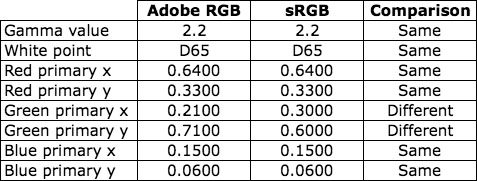Color gamut is a popular concept in digital color management, and is frequently mentioned in discussions about the selection of a color space (e.g., sRGB or ProPhoto RGB) or the compression of colors in a color-managed workflow. Color gamut volume and color gamut boundary colors are the two aspects of a color gamut that get the most attention, and both provide useful information.
Unfortunately, the concept of a color gamut has been applied to color imaging devices that do not actually have a color gamut. Only devices, or systems, that render color have a color gamut. To quote Dr. Roy S. Berns from RIT in the book Billmeyer and Saltzman’s Principles of Color Technology, “Color gamut: Range of colors produced by a coloration system.” To be a little clearer about this, the concept of a color gamut applies to systems that produce color (e.g., color printer, color television, color monitor, or color projector).
The concept of a color gamut is not relevant to systems, or devices, that measure color. In the context of digital color imaging, a color measurement device is exposed to colored light and delivers a set of digital values to represent that colored light. The obvious examples are colorimeters and spectrophotometers, which are used in scientific color measurement work. Digital color cameras and scanners are also color measurement devices. These devices do not render or produce color, they measure color. Therefore, none of them have a color gamut.
We can characterize a color measurement device, with some constraints on the exposure conditions, and use that characterization in an ICC profile for that device (e.g., an ICC profile for a digital color camera or a color film scanner). But that characterization is not the same as a color gamut. The characterization may look a lot like a color gamut in a software tool that displays color gamuts and device characterizations, and that may be the reason why people think the concept of a color gamut is relevant for digital color cameras.
Another contributing factor to the confusion is the option on a digital color camera to choose an RGB color space (e.g., sRGB, Adobe RGB (1998), or ProPhoto RGB) for the encoding of a photograph within the digital color camera. These RGB color spaces are convenient color spaces that simplify color management of a digital photograph downstream from the digital camera. Encoding a digital photograph in one of these RGB color spaces will constrain the digital photograph to the gamut of the color space (Yes, each of these RGB color spaces has a color gamut that is constrained by the colorimetric values of the red, green, and blue primaries of the color space). It will also tie the digital photograph to the white point of the color space and establish the digital resolution within the color space (e.g., 8-bits per channel or 16-bits per channel). But the selected RGB color space is not the color gamut of the digital camera. If this distinction is not obvious after you have read the entire blog post, please leave a comment and I will go into more detail.
I recognize that it is easier to understand color management when we can see the color gamut of each device displayed in the same color space. Unfortunately, we cannot display the color gamut of a digital color camera in CIELAB space, or the CIE xy chromaticity space, for comparison with the color gamut of a color monitor or a color printer because the digital color camera does not have a color gamut. I am sympathetic with the desire to give a digital color camera a color gamut in order to facilitate a comparison to color rendering devices. The good news is that we have a simple solution: device characterization with a common colorimetric color space (e.g., CIELAB).
In the practical application of a color management system, the characterization of a color-imaging device is the information that enables color management. This is true for any color rendering device and any color measurement device in the digital color workflow. The data within an ICC profile are based on characterization data, not the limits of a color gamut. The information taken from an ICC profile and rendered by software tools to visualize the color volume and boundaries of the color-imaging device is based on the characterization data. We should keep this in mind when someone incorrectly talks about the color gamut for a digital camera. We know that a digital color camera does not have a color gamut, but we can talk about the characterization of a digital camera, or the selection of a standard RGB color space within the camera, and frame the discussion in that context.
Post written by Parker Plaisted
References:
R. S. Berns, Billmeyer and Saltzman’s Principles of Color Technology, 3rd Edition, John Wiley & Sons, New York, N.Y. (2000).
International Color Consortium, ICC Profile Format Specification. (http://www.color.org)
Imaging FAQ on the RIT CIS Munsell Color Science Laboratory (MCSL) Website https://www.rit.edu/cos/colorscience/rc_faq_faq3.php#255









